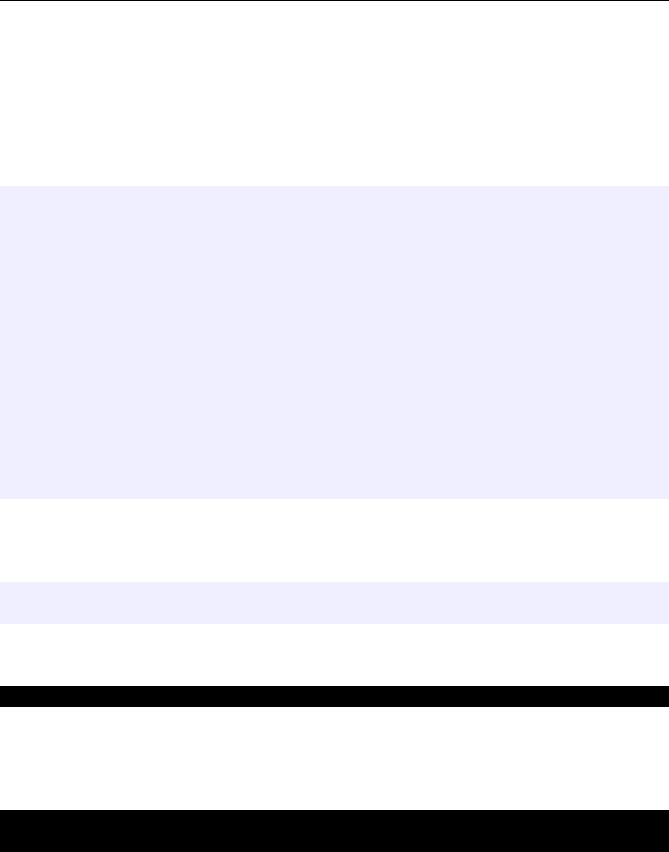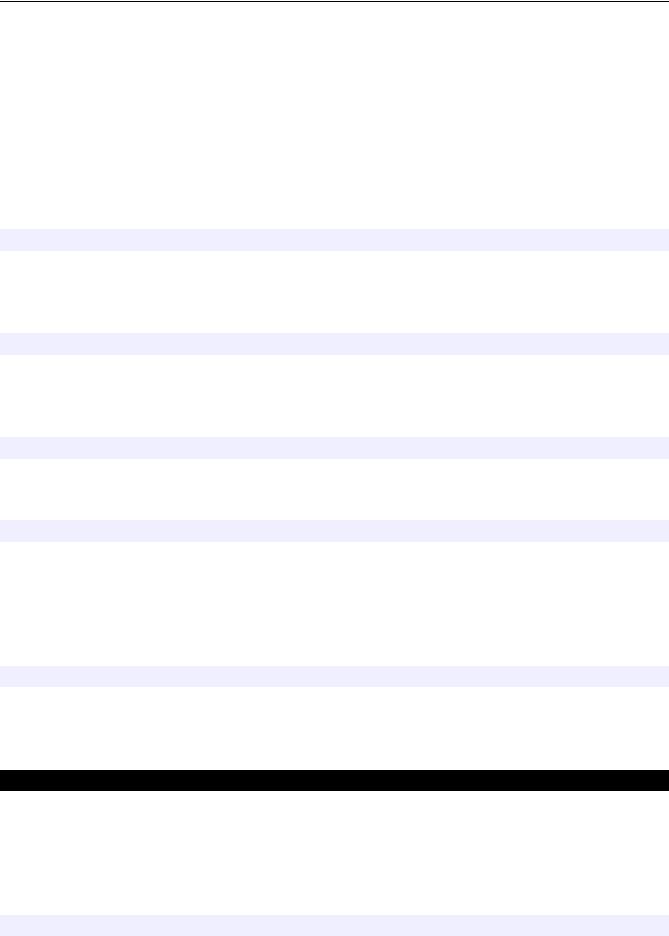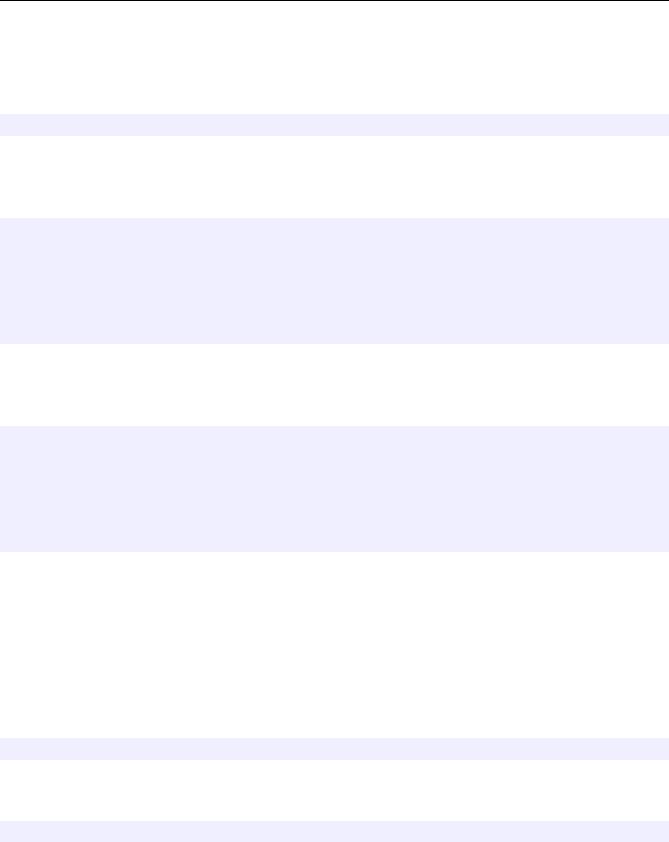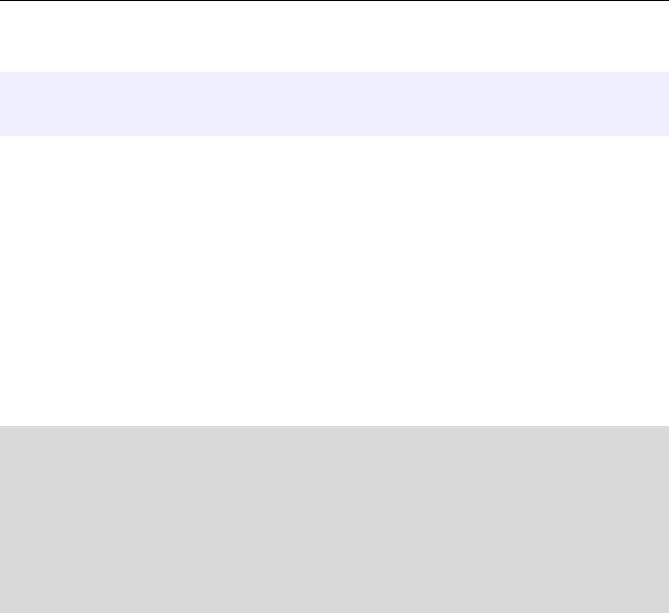
- •Foreword
- •About Programmer’s Heaven
- •About Faraz Rasheed
- •Contents In Summary
- •Tools of the trade
- •The C# Language
- •The .Net Architecture and .Net Framework
- •The Common Language Runtime (CLR)
- •MSIL (Microsoft Intermediate Language) Code
- •Just In Time Compilers (JITers)
- •The Framework Class Library (FCL)
- •The Common Language Specification (CLS)
- •The Common Type System (CTS)
- •Garbage Collection (GC)
- •The .Net Framework
- •C# compared to C++
- •The Visual Studio.Net IDE
- •Projects and Solutions
- •Toolbox, Properties and Class View Tabs
- •Writing Your First Hello World Console Application in C#
- •Working Without Visual Studio.Net
- •With Visual Studio.Net
- •Understanding the Hello World Application Code:
- •Namespaces in C#
- •The using Keyword
- •The class Keyword
- •The Main() Method
- •Printing on the Console
- •Comments
- •Important points to remember
- •A more interactive Hello World Application
- •Discussing a more interactive Hello World Application
- •2. C# Language Fundamentals
- •Lesson Plan
- •Basic Data Types and their mapping to CTS (Common Type System)
- •Integral Types
- •Floating Point Types
- •Other Types
- •Variables
- •Constant Variables or Symbols
- •Naming Conventions for variables and methods
- •Operators in C#
- •Arithmetic Operators
- •Operand
- •Prefix and Postfix notation
- •Assignment Operators
- •Operand
- •Relational Operators
- •Operand
- •Operand
- •Other Operators
- •Operand
- •Operator Precedence
- •Flow Control And Conditional Statements
- •The if...else statement
- •The switch...case statement
- •Loops In C#
- •The for Loop
- •Some important points about the for loop
- •The do...while Loop
- •while Loop
- •Arrays in C#
- •Array Declaration
- •Accessing the values stored in an array
- •foreach Loop
- •3. Classes and Objects
- •Lesson Plan
- •Concept of a Class
- •Objects
- •Fields
- •Data Type
- •Methods
- •Instantiating the class
- •Accessing the members of a class
- •Access Modifiers or Accessibility Levels
- •Access Modifier
- •Properties
- •Using Properties
- •Precautions when using properties
- •Static Members of the class
- •Some More about Methods
- •Constructors
- •Finalize() Method of Object class
- •Destructors
- •Method and Constructor Overloading
- •Overloading Constructors
- •Value types (out & ref Keywords)
- •Reference types
- •Some more about references and objects
- •4. Inheritance & Polymorphism
- •Lesson Plan
- •Inheritance
- •Inheritance in C#
- •Implementing inheritance in C#
- •Constructor calls in Inheritance
- •The base keyword - Calling Constructors of the base-class explicitly
- •Protected Access Modifier
- •The Protected internal Access Modifier
- •The sealed keyword
- •Object class - the base of all classes
- •Polymorphism
- •Using the reference of the base type for referencing the objects of child types
- •Using methods with the same name in the Base and the Sub-class
- •Overriding the methods - virtual and override keywords
- •The new keyword
- •Type casting the objects - Up-casting and Down-casting
- •The is and as keywords
- •Boxing and Un-boxing
- •5. Structures, Enumeration, Garbage Collection & Nested Classes
- •Lesson Plan
- •Structures (struct)
- •Defining a struct
- •Instantiating the struct
- •structs as Value Types
- •Enumeration
- •The Need for Enumeration
- •Using Enumeration (enum)
- •More about Enumerations
- •Garbage Collection in .Net
- •Destructors and Performance Overhead
- •System.GC.Collect() method
- •Nested Classes in C#
- •6. Abstract Classes & Interfaces
- •Lesson Plan
- •Abstract Classes
- •Interfaces
- •Implementing More Than One Interface
- •Explicit implementation of methods
- •Casting to an interface using is and as operators
- •An interface inheriting one or more interfaces
- •7. Arrays, Collections & String Manipulation
- •Lesson Plan
- •Arrays Revisited
- •Multidimensional Arrays
- •Instantiating and accessing the elements of multidimensional arrays
- •Instantiating and accessing Jagged Arrays
- •Some other important points about multidimensional arrays
- •The foreach Loop
- •Collections
- •The ArrayList class
- •The Stack class
- •The Queue class
- •Dictionaries
- •The Hashtable class
- •Constructing a Hashtable
- •Adding items to a Hashtable
- •Retrieving items from the Hashtable
- •Removing a particular item
- •Getting the collection of keys and values
- •Checking for the existence of a particular item in a hashtable
- •The SortedList class
- •String Handling in C#
- •The string class and its members
- •The StringBuilder class
- •8. Exception Handling
- •Lesson Plan
- •Exceptions Basics
- •The need for Exceptions
- •Exceptions in C# and .Net
- •Handling Exceptions using the try...catch...finally blocks
- •Use of the try...catch block
- •Exception class' Message and StackTrace Properties
- •The finally block
- •Catching Multiple Exceptions using multiple catch blocks
- •An important point to remember in multiple catch blocks
- •Other important points about Exception Handling in C#
- •Defining your own custom exceptions
- •Exception Hierarchy in the .Net Framework
- •Throwing an exception: the throw keyword
- •9. Delegates & Events
- •Lesson Plan
- •Delegates Basics
- •The type or signature of the method the delegate can point to
- •The delegate reference, that can be used to reference a method
- •3.The actual method referenced by the delegate
- •Calling the actual method through its delegate
- •Confusion in terminology
- •Delegates in the .Net Framework
- •Passing delegates to methods
- •Multicast Delegates
- •Implementing a Multicast Delegate
- •Removing a method from the multicast delegate's invocation list
- •Events and Event Handling
- •Event Handling in C#
- •A Clock Timer Example
- •Multicast events
- •Passing some data with the Event: Sub-classing System.EventArgs
- •10. WinForms & Windows Applications
- •Lesson Plan
- •Windows Applications and .Net
- •WinForm Basics
- •Building the "Hello WinForm" Application
- •Understanding the Code
- •Adding Event Handling
- •Visual Studio.Net & its IDE (Integrated Development Environment)
- •IntelliSense and Hot Compiler
- •Code Folding
- •Integrated Compiler, Solution builder and Debugger
- •Form Designer
- •Solution Explorer
- •Menus in the Visual Studio .Net IDE
- •Using Visual Studio.Net to build the "Hello WinForm" Application
- •Creating a new Project
- •Setting various properties of the form
- •Adding Controls to the Form
- •Adding Event Handling
- •Executing the application
- •The code generated by the Form Designer
- •Using More Controls
- •Using various controls in an application: Programmer's Shopping Cart
- •Designing the form and placing the controls
- •Writing Code for Event Handling
- •Some Important Points for designing Windows Applications
- •11. More Windows Controls & Standard Dialog Boxes
- •Lesson Plan
- •Collection Controls
- •List Box Control
- •Adding items to the list box
- •Accessing items in the list box
- •Removing items from the list box
- •List Box Events
- •Combo Box Control
- •Tree View
- •The TreeNode Editor
- •Adding/Removing items at runtime
- •Tree View Events
- •Image List Control
- •Attaching An Image List to different controls
- •List View Control
- •Two Image Lists in the List View Control
- •Adding items to the list view control using designer
- •Adding Items at runtime using code
- •Events for List View Control
- •Main Menu
- •Tool Bar
- •Date Time Picker
- •Windows Standard Dialog Boxes
- •Open File Dialog Box
- •Using the Open File Dialog Box
- •Save File Dialog Box
- •Font and Color Dialog Boxes
- •12. Data Access using ADO.Net
- •Lesson Plan
- •Introducing ADO.Net
- •Different components of ADO.Net
- •A review of basic SQL queries
- •SQL SELECT Statement
- •SQL INSERT Statement
- •SQL UPDATE Statement
- •SQL DELETE Statement
- •Performing common data access tasks with ADO.Net
- •Accessing Data using ADO.Net
- •Defining the connection string
- •Defining a Connection
- •Defining the command or command string
- •Defining the Data Adapter
- •Creating and filling the DataSet
- •A Demonstration Application
- •Loading tables
- •Filling the controls on the Form
- •Navigating through the records
- •Updating the table
- •Building the Application
- •Loading the table and displaying data in the form's controls
- •Initialing Commands
- •Adding Parameters to the commands
- •The ToggleControls() method of our application
- •Editing (or Updating) Records
- •Event Handler for the Save Button
- •Event Handler for the Cancel Button
- •Inserting Records
- •Deleting a Record
- •Using Stored Procedures
- •Sample Stored Procedures
- •UPDATE Stored Procedure
- •INSERT Stored Procedure
- •DELETE Stored Procedure
- •SELECT Stored Procedure
- •Using Stored Procedures with ADO.Net in C#
- •The modified InitializeCommands() method
- •Using Data Grid Control to View .Net data
- •A Demonstration Application for Data Grid Control
- •Second Demonstration - Using multiple related tables
- •Retrieving data using the SELECT command
- •Updating Records using INSERT, UPDATE and DELETE commands
- •13. Multithreading
- •Lesson Plan
- •What is Multithreading
- •Multithreading in C#
- •Thread Functionality
- •Static members of the System.Threading.Thread class
- •Instance members of the System.Threaing.Thread class
- •Thread Demonstration Example - Basic Operations
- •Thread Demonstration Example - Thread Priority
- •Thread Demonstration Example - Thread Execution Control
- •Using Join() to wait for running threads
- •Thread Synchronization
- •The C# Locking Mechanism
- •Threads may cause Deadlock
- •14. The File System & Streams
- •Lesson Plan
- •Working with the File System
- •Obtaining the Application’s Environment Information – The System.Environment class
- •Demonstration Application – Environment Information
- •Obtaining the paths of various Windows Standard folders – Environment.GetFolderPath()
- •Manipulating Files using System.IO.File and System.IO.FileInfo classes
- •System.IO.File class
- •Creating a file using Create() method
- •Copying and Moving a file using Copy() and Move() methods
- •Checking the existence of the file using Exists() method
- •Getting Attributes of a file using GetAttributes() method
- •System.IO.FileInfo class
- •A quick and simple example
- •Manipulating Directories (folders) using System.IO.Directory and System.IO.DirectoryInfo classes
- •System.IO.Directory class
- •Creating, deleting and checking for the existence of directories
- •Getting the contents (files and sub-directories) of a directory
- •System.IO.DirectoryInfo class
- •Demonstration application for the DirectoryInfo class
- •Streams
- •An overview of the different types of streams
- •The System.Stream class – the base of all streams in the .Net framework
- •Different types of file streams – Reading and Writing to files
- •Using System.IO.FileStream to read and write data to files
- •A string representing the path and name of the file
- •Opening and reading from a file
- •Using BinaryReader and BinaryWriter to read and write primitives to files
- •Using StreamReader and StreamWriter to read and write text files
- •Serialization and De-serialization
- •Implementing Serialization and Deserialization – A simple example
- •Formatters in Serialization
- •Preventing certain elements from Serializing – The [NonSerialized] attribute
- •Getting notified when Deserializing - the IDeserializationCallBack interface
- •Asynchronous Reading and Writing with Streams
- •A demonstration application
- •Issues Regarding Asynchronous Read/Write
- •Important points regarding the use of Streams
- •15. New Features In C# 2.0
- •C# evolves
- •The need for generics
- •Generic collections
- •Creating generic types
- •Constraining type parameters
- •Final thoughts on generics
- •Partial types
- •Nullable types
- •Anonymous methods in event handling
- •Adventures with anonymous methods
- •Final thoughts on C# 2.0
- •16. The Road Ahead
- •Learning More
- •Getting Help
- •Book.revision++
- •Good Luck!

Programmers Heaven: C# School
The new keyword
Suppose, in our Circle class, we don't want to override the Draw() method, but we need to have a Draw() method, what we can do? In Java, we can't do this. In C++, even if we mark the method in the base class as virtual, it is impossible. But, C# introduces a keyword new to mark a method as a non-overriding method and as the one which we don't want to use polymorphically. Let us define the Shape and Circle classes as:
class Shape
{
public virtual void Draw()
{
Console.WriteLine("Drawing Shape...");
}
}
class Circle : Shape
{
public new void Draw()
{
Console.WriteLine("Drawing Circle...");
}
}
Note that we marked the Draw() method in Circle with the new keyword to avoid polymorphism. In our method we write
Shape theShape = new Circle();
theShape.Draw();
When we compile and run the above code, we will see the following output:
Drawing Shape...
Since, we marked the Draw() method in the Circle class as new, no polymorphism is applied here and the Draw() method of the Shape class is called. If we don't mark the Draw() method with the new keyword, we will get the following warning at compile time:
'CSharpSchool.Circle.Draw()' hides inherited member
'CSharpSchool.Shape.Draw()'.
To make the current member override that implementation, add the override keyword. Otherwise add the new keyword.
95

Programmers Heaven: C# School
Type casting the objects - Up-casting and Down-casting
Type Casting means 'making an object behave like' or 'changing the apparent type of an object'. In C#, you can cast an object in an inheritance hierarchy either from the bottom towards the top (up-casting) or from the top towards the bottom (down-casting).
Up-casting is simple, safe and implicit, as we have seen the reference of parent type can reference the object of child type.
Parent theParent = new Child();
On the contrary, down-casting is un-safe and explicit. By un-safe, we mean it may throw an exception – that is, fail. Consider the following line of code:
Shape [] shapes = { new Circle(), new Rectangle(), new Curve() };
Where Circle, Rectangle and Curve are sub-classes of Shape class. Now, if we want to reference the Rectangle object in the shapes array with the reference of type Rectangle, we can't just write
Rectangle rect = shapes[1];
Instead, we have to explicitly apply the cast here as
Rectangle rect = (Rectangle) shapes[1];
Since the cast is changing the apparent type of the object from parent to child (downward direction in inheritance hierarchy), it is called down-casting.
Also, note that down-casting can be unsuccessful and if we attempt to write
Rectangle rect = (Rectangle) shapes[2];
Since shapes[2] contains an object of type Curve which can not be casted to the Rectangle type, the CLR would raise the following exception at run-time:
System.InvalidCastException: Specified cast is not valid.
The is and as keywords
To check the run-time type of an object, you can use either the is or the as keyword. is compares the type of the object with the given type and returns true if it is cast-able; otherwise, it returns false. For example,
Console.WriteLine(shapes[1] is Rectangle);
96

Programmers Heaven: C# School
would print true on the Console Window, while
Console.WriteLine(shapes[2] is Rectangle);
would print false on the Console window. We might use the is operator to check the runtime type of an object before applying down-casting.
Shape [] shapes = { new Circle(), new Rectangle(), new Curve() };
Rectangle rect=null;
if(shapes[1] is Rectangle)
{
rect = (Rectangle) shapes[1];
}
Alternatively, we can also use the as operator to check the run-time type of the object. The as operator returns null if the object is not cast-able otherwise, it casts the object to the specified type as
Shape [] shapes = { new Circle(), new Rectangle(), new Curve() };
Rectangle rect = shapes[1] as Rectangle;
if(rect != null)
Console.WriteLine("Cast successful");
else
Console.WriteLine("Cast unsuccessful");
Although is and as perform similar functionality, is just checks the runtime type while as in addition to this, also casts the object to the specified type.
Boxing and Un-boxing
The last topic for today is boxing and un-boxing. Boxing allows value types to be implicitly treated like objects. Suppose, we have an integer variable i declared as
int i = 5;
when we write
i.ToString();
The Compiler implicitly creates an instance of the Object class and boxes (stores) a copy of this int value (5) in the object. It then calls the ToString() method on the instance of the Object class which has boxed the copy of the int value. It is similar to writing
97

Programmers Heaven: C# School
int i = 5;
Object obj = i; |
// implicit boxing |
obj.ToString();
You can see in the above code that boxing is implicitly applied in C# and you don't have to write
Object obj = (Object) i; |
// unnecessary explicit boxing |
|
|
On the other hand, un-boxing is explicit conversion from object type to value type. The following lines show how un-boxing is implemented in C#
int |
i |
= 5; |
|
|
Object obj |
= i; |
// implicit boxing |
||
int |
j |
= (int) obj; |
// explicit un-boxing |
|
|
|
|
|
|
Like down-casting, un-boxing can be un-safe and throw an InvalidCastException at runtime.
Author's Note: Although boxing and un-boxing look very similar to up-casting and down-casting, there are some points that differentiate the two:
Boxing and Un-boxing are the transformations between value type and object, while casting just transforms the apparent (reference) type of objects.
Value types are stored on the stack and objects are stored in the heap. Boxing takes a copy of the value type from the stack to the heap while un-boxing takes the value type back to the stack. On the other hand, casting does not physically move or operate on the object. Casting merely changes the way objects are treated in a program by altering their reference type.
98
